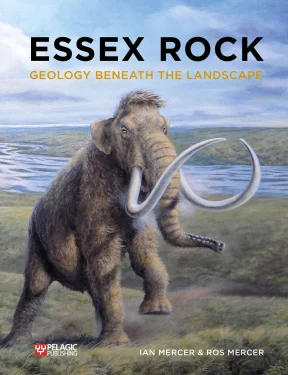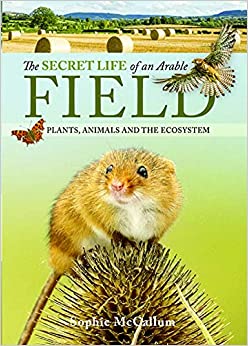During 2022, we have been asked to review three books. Our reviews below show what a mixed bag reviewing can throw up, from incredibly positive to downright awful, should never have seen the light of day. Presented in order of best first, the first two have been published in the journals as detailed, but the third is published here for the first time.
—————————————————————————————————————
Essex Rock: Geology beneath the landscape by Ian Mercer & Ros Mercer. Pelagic Publishing, 2022. £29.99 paperback.
In 2000, I was asked to review the first edition of this book, then authored by Gerald Lucy. My view of it was almost wholly favourable, and indeed it has become a frequent reference point for me over the ensuing two decades.
This new edition simply makes it more indispensable for someone like me without a formal geological background. The larger format and almost four times as many pages allow the ideas in the book the space to breath, and to be supported by a much richer wealth of photos and images. The authors have done a great service to the naturalist community in producing enjoyable, readable text without sacrificing erudition. The simple, clear design also helps, although to my eyes at least the font of the body text is ever so slightly too weak for comfort.
Essex is a ‘soft rock’ county, relatively young, lacking in relief and many of the dramatic landforms found elsewhere, and in which many of the geological sites remain largely, stubbornly sub-surface – in other words, it is an acquired taste. The breadth of coverage is breathtaking, from long before the times of our earliest surface rocks to a distant, conjectured future, all told as a coherent story through time.
The easy writing style also lends itself well to something one might not expect in a book like this: humour. Just go and buy it and read to the end of p374 to see for yourself! Even if you have the first edition, do get this – it has so much more to add, and of course the science has progressed over the 20 years. But don’t get rid of the old one. At only 259g as compared with 1180g, the first is a whole lot more portable, if you wish for example to take the gazetteer of important sites (found in both editions) around with you in the field.
Essential for anyone with an interest in Essex and soft-rock landscapes, this book is also for the person who just thinks they might be interested. After a few minutes you surely will be. I already know many of the key sites in it as I notified a good proportion of them as SSSIs but it has renewed my desire to get out and see them again with refreshed eyes.
Published in Country-Side, 36 (1) Winter 2022, 32.
—————————————————————————————————————
Habitats of the World: A Field Guide for Birders, Naturalists and Ecologists by Iain Cambell, Ken Behrens, Charley Hesse & Phil Chaon. Princeton University Press, ISBN: 9780691197562. September 2021. 568 pages. £28 flexibound.
 Hugely ambitious in scope, this guide aims to cover and describe all the main broad habitats of the world, each of the six major zoogeographic zones being allocated some 80 pages. Such a compilation of information, mostly reflecting the experience of the authors, is a remarkable achievement.
Hugely ambitious in scope, this guide aims to cover and describe all the main broad habitats of the world, each of the six major zoogeographic zones being allocated some 80 pages. Such a compilation of information, mostly reflecting the experience of the authors, is a remarkable achievement.
However, it does not fulfil the promise of its subtitle. Although ‘field guide’ in format, it weighs nearly 1.3kg, not something one would be lugging to all corners of the world, where in each of which only a small subset of the pages will ever be relevant. Birders (and to some extent those interested in mammals and reptiles) are well catered for; botanists may well be disappointed as, while plants are mentioned, few have images; and entomologists will find nothing. So ‘naturalists and ecologists’ could well feel let down, with good reason.
Well laid-out, with a very readable typeface and flexi-bound, the book looks and feels worthwhile, and the habitat sketches commendably use a female icon for scale. Mapping could be clearer: complex coastlines like western Scotland appear shaded, and so apparently have part of the distribution of Garrigue, for example. And the use of black rather than greyed-out for extra-zonal parts of the maps is simply ugly. Other personal niggles include the punctuation in geographic descriptors (sc. for south-central); internal capitalization in compound names (e.g., Sand-Plover); the over-repetition of organisation names (eg Tropical Birding Tours) in photographic credits; and the subjective and excessively sporadic use of IS for Indicator Species.
Errors seem to be remarkably few but we did spot Viburnum opulus masquerading as ‘Cranberry’ in the plant list, and Northern Bald Ibis erroneously described as ‘extirpated’ in the Palearctic garrigue zone (it thankfully remains in Morocco).
Given the breadth of scope, necessarily and not unreasonably the ‘habitats’ are broadly defined, making it much less useful as a field guide than say WILDGuides’ Britain’s Habitats, but as an authoritative gateway guide to the world’s habitats, we know of nothing which comes anywhere near this volume. We will use it as a home reference if not a field guide.
Published in British Naturalists Association News Bulletin Issue 11, February 2022 pp 15-16.
—————————————————————————————————————-
And so to the final book, one that should never have been printed in its present form. Let down by the lack of professional editing, appalling picture research and perhaps the knowledge of the author herself, it is a masterclass in how not to publish a wildlife book. Which is sad – the book has something important to say if one can get past the errors; we have of course offered to send a detailed list of corrections to the publishers if they wish to reprint, but we have not heard from them.
The Secret Life of an Arable Field – Plants, Animals and the Ecosystem by Sophie McCallum. WhiteOwl/Pen and Sword Books (2021). 250 pages, £25 hardback.
First feel of this book is of quality, case-bound with headband and an attractive dust-jacket: it is a book which will last. Sadly, to our eyes, the quality of the package is let down by the overly glossy paper, though we accept this is a personal preference.
The front flap of the dust-jacket lays out the rationale of the book, which is not reiterated elsewhere, rather oddly, as dust-jackets can and do get lost. The book is unpretentious in not having a lengthy introduction or foreword; in lieu of these the first text page covers some of the same ground as the jacket, five short factual paragraphs, each on an aspect related to current farming practice – for example subsidies, pesticide-usage and planning/development. All pertinent, but messages not repeated as often as perhaps they should be throughout the book. Of course, those seeking a ‘celebration’ of the biodiversity of arable life might welcome this; others may see it as a missed opportunity at a time when even highly productive arable land which feeds us is under threat like never before from house-building, developers being desperate to make their money before the stark demographic messages of the post-Brexit post-Covid era hit home.
The main pages highlight 120 species, or species groups, of plants, animals and fungi, listed alphabetically (by English name) for easy reference. There is no index, which might have been helpful to accommodate alternative names, for example ‘Blackthorn’ as well as ‘Sloe’. Each tries to be a mini-essay about the subject, telling some of the stories associated with these organisms, and explaining their interconnectivity and importance, and does indeed provide a lot of useful and interesting information – even the expert is likely to learn something. But there is a bit of a disconnect between successive paragraphs, and sometimes even between sentences within a paragraph, such that it reads a bit like bullet points, without the bullets…
Each subject is illustrated with a single photograph, we presume by the author, although we cannot find any reference to this. Some are excellent and evocative, while others are less successful, for example those of Corn Marigold, Ragwort and Primrose, where the visiting insects are sharp, but the flowers themselves are largely out of focus or poorly exposed. Unfortunately the varying length of the mini-essays with a single photo leaves a number of awkward blank half pages, which could perhaps have been filled with additional photos.
The choice of ‘species’ to include has taken an unfeasibly broad view of ‘arable’, of landscapes rather than strictly the habitat, thus permitting the inclusion of grassland species (eg Meadow Buttercup), woodland species (eg Sweet Chestnut) and heathland/upland (or garden) species (eg Juniper).
Typos and textual errors are almost absent (thankfully). There are however too many factual errors in the text. For example, Birch bark is said contain high concentrations of ‘botulin’, while it actually contains ‘betulin’, two very different chemicals with very different properties. The second introductory paragraph ends with a nonsensical sentence: in it ‘pests’ should read ‘predators’. And some of the photos do not actually show what they purport to: the ‘Goat Moth’ is actually an Early Grey moth; the ‘Small Emerald’ is a Large Emerald; the ‘Dog Rose’ is a semi-double garden Rose cultivar; the ‘(stinging) Nettle’ is a ‘White Dead-nettle’; the ‘Daisy’ is a mayweed; the ‘Cow Parsley’ is Hogweed, and there are several others. Such errors seriously let the rest of the book down: facts matter!
Setting aside the errors, who might this book appeal to? Certainly its geographic focus is primarily the UK, although anyone from here would be surprised (as Defra would be concerned) to find Colorado Beetle on our shores, and the butterfly above the ‘Daisies’ would raise eyebrows anywhere this side of the Atlantic and/or outside the sub-tropics. It is not a book for the expert, and the errors we have found suggest it could not be relied upon as a reference book. However it is undeniably attractive, and will help to raise awareness of the importance of the wildlife of farmed landscapes, especially perhaps to those faced with the impending loss of their own local valued patches. This is the case for the author: the fields she looks over while writing, watching the Red Kites, now have planning permission – to provide more homes for people but at the expense of homes for the creatures who have traditionally been there. Therapy for the author perhaps, and a rallying call for others we hope.
Notwithstanding its failings, the fundamental message of this book is very apt for our times – ‘our havens of nature are being destroyed’. Enjoy it while you can…

